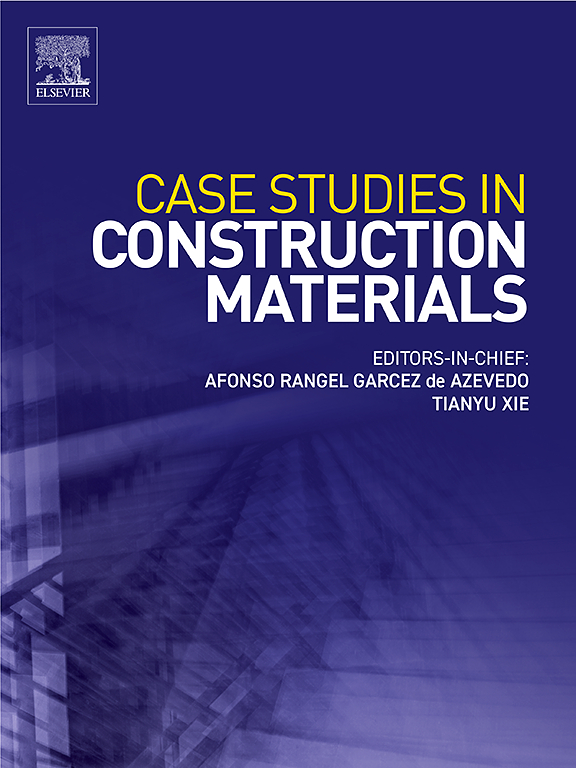Improving mechanical performance and reducing CO2 emissions of cement-based composites via one-step synthesis of highly dispersed flake g-C3N4
IF 6.6
2区 工程技术
Q1 CONSTRUCTION & BUILDING TECHNOLOGY
引用次数: 0
Abstract
Graphitic carbon nitride (g-C3N4) has demonstrated significant potential in enhancing the mechanical properties of cement-based materials. However, the poor dispersibility and complex preparation of bulk g-C3N4 (B-CN), along with the lack of research on its environmental impact, remain major obstacles to its widespread application. To address this issue, this study employs a one-step method to synthesize highly dispersed flake g-C3N4 (F-CN) for improving the mechanical properties and reducing the CO2 emissions of cement-based composites, and investigates the underlying mechanisms. In addition, the CO2 emissions of F-CN-modified cement are evaluated. Specifically, F-CN exhibits significantly higher dispersibility and a smaller particle size (20–80 nm), allowing it to be directly applied to cement-based systems without the need for additional dispersing agents. The highly dispersible F-CN is more favorable for accelerating cement hydration and refining the microstructure. Compared with the control and B-CN groups, F-CN increases the 28-day compressive strength of cement paste specimens by 8.65 % and 16.90 %, respectively. Moreover, compared with conventional cement and B-CN-modified cement, F-CN-modified cement reduces CO2 emissions during production by 14.37 % and 6.37 %, respectively. This study proposes a simple and effective approach for improving both the performance and environmental profile of cement-based composites using highly dispersed flake g-C3N4, offering new insights into nanomaterial–cement interactions and contributing to low-carbon construction solutions.
通过一步法合成高分散片状g-C3N4提高水泥基复合材料的力学性能并降低二氧化碳排放
石墨氮化碳(g-C3N4)在提高水泥基材料的力学性能方面显示出巨大的潜力。然而,体g-C3N4 (B-CN)的分散性差、制备复杂,以及对其环境影响的研究不足,仍然是其广泛应用的主要障碍。为了解决这一问题,本研究采用一步法合成高度分散的片状g-C3N4 (F-CN),以改善水泥基复合材料的力学性能和减少二氧化碳排放,并探讨其潜在机制。此外,还对f - cn改性水泥的CO2排放量进行了评价。具体来说,F-CN表现出更高的分散性和更小的粒径(20-80 nm),使其可以直接应用于水泥基体系,而无需额外的分散剂。高分散性的F-CN更有利于加速水泥水化和细化微观结构。与对照组和B-CN组相比,F-CN可使水泥浆体试件28天抗压强度分别提高8.65 %和16.90 %。此外,与常规水泥和b - cn改性水泥相比,f - cn改性水泥在生产过程中分别减少了14.37 %和6.37 %的二氧化碳排放量。本研究提出了一种简单有效的方法,利用高度分散的片状g-C3N4提高水泥基复合材料的性能和环境特征,为纳米材料-水泥相互作用提供了新的见解,并为低碳建筑解决方案做出了贡献。
本文章由计算机程序翻译,如有差异,请以英文原文为准。
求助全文
约1分钟内获得全文
求助全文
来源期刊

Case Studies in Construction Materials
Multiple-
CiteScore
7.60
自引率
19.40%
发文量
842
审稿时长
63 days
期刊介绍:
Case Studies in Construction Materials provides a forum for the rapid publication of short, structured Case Studies on construction materials. In addition, the journal also publishes related Short Communications, Full length research article and Comprehensive review papers (by invitation).
The journal will provide an essential compendium of case studies for practicing engineers, designers, researchers and other practitioners who are interested in all aspects construction materials. The journal will publish new and novel case studies, but will also provide a forum for the publication of high quality descriptions of classic construction material problems and solutions.
 求助内容:
求助内容: 应助结果提醒方式:
应助结果提醒方式:


